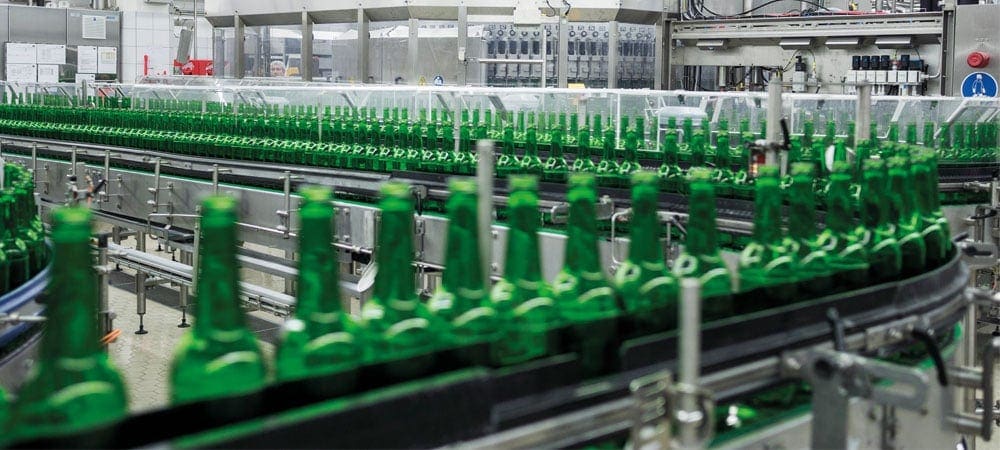Transformation project with pioneering character


The task was therefore to merge the company codes of both companies in S/4. A project with pioneering character. Together with cbs, KHS carefully prepared the technically demanding merger, initiated a change management process, and successfully implemented the merger in a very short time. The KHS Group is one of the leading manufacturers of filling and packaging systems in the beverage and liquid food sectors, with its headquarters in Dortmund. The long-established company operates worldwide and has a high export ratio.
The development and production of complete filling and packaging systems as well as individual machines for the beverage and liquid food sectors form the core competence of KHS. In 2020, the Group generated sales of €1.13 billion with 5085 employees. Formed in 1993 from the merger of Holstein and Kappert, founded in Dortmund in 1868, and Seitz-Werke, established in Bad Kreuznach in 1887, KHS is one of the leading suppliers on the market. The Group is a wholly owned subsidiary of Salzgitter Klöckner-Werke, which belongs to the Salzgitter Group.
With the acquisition of Corpoplast to form KHS in 2008, the Group focused on expanding its PET expertise. At its site in Hamburg, KHS offers its customers a comprehensive range of advice on plastic containers and also manufactures machines for producing and coating plastic containers. Customers include renowned beverage brands all over the world.
Close intercompany linkage
In order to make the processing of orders even more efficient, the company set up a comprehensive road map program two years ago. The aim was to consolidate the existing eleven different SAP systems. One requirement was to migrate the KHS subsidiaries worldwide to the new S/4 system. All companies were to work with one ERP system in the future.
"We already had very close intercompany links. Numerous orders came from the parent company and the interdependencies became closer and closer. Therefore, it was a corporate goal of the Group to harmonize these processes"explains Mathias Offermann, Vice President IT at KHS. The subsidiary Corpoplast was to be fully integrated into the group, which is why the IT processes had to be adapted accordingly. The aim was to reduce the amount of work involved in orders from the parent company and subsequent invoices in order to make internal processes more efficient and thus increase profitability.
"Due to the size and complexity of the company, this company code merger was challenging, as there are 400 employees in Hamburg after all. The entire value chain is covered there, including design, production or shipping. All SAP modules are in use there and the volume was really high.says Mark Dinnups, Head of Global SAP Services.
The biggest challenge in the project was the complex consolidation and data migration in Finance & Controlling under the new S/4 Hana structures, and this within a very short time span of less than six months. In addition, a suitable phase-out strategy had to be developed for old projects. There were differences between the old and new systems in terms of the type of billing document, i.e. between HGB and percentage-
of Completion (PoC method). During the transition phase, it was necessary to work with two systems simultaneously. Users therefore had to check which type of project was being worked with in each individual case during this phase and act accordingly. This again increased the complexity of the project.
"We were very helped by the support we received from professional change management."emphasizes Jens Jensen, head of KHS' Plant Controlling Team North. All Corpoplast employees were taken along on the road to integration. "This was a challenging process. Because the good cohesion in the workforce and the identity of the site had to be maintained. It was important for us to keep the motivation of the users high to participate in the tests."Jensen explains.
The standard software cbs ET Enterprise Transformer was used for the data migration. In the process, the project team discussed and tapped all the technical possibilities of the tool, procedures and migration paths at an early stage. Company code mergers are nothing new, but in S/4 cbs carried out such a merger for the first time. In the S/4 environment, this is probably also one of the first mergers in the world to be implemented using SLT technology. Through this project, valuable insights have been gained and the company has become even more sensitive with regard to critical issues: In S/4, compared to SAP ERP/ECC 6.0, there are different data structures, different tables and different access sequences. These behave quite differently. This is very complex, and it is therefore important to work with the right tools during such a migration.
Mark Dinnups, Head of Global SAP Services: "We achieved a remarkable merger in just four months. We migrated in the existing system with a very short cutover phase, with very little operational aftermath and without any inconsistencies. Everything ran smoothly. This is a case that does not exist on the market today."
Migration and optimization
Mathias Offermann from KHS explains: "In a migration like this, we look at the core processes. Of course, we want operations to continue as smoothly as possible. That worked very well - even if the complete accounting system aggregates the figures quite differently afterwards." After the go-live, users were able to continue working on orders, deliveries, invoices, or projects exactly where they had left off before. As KHS is a global company there is always a need for optimization in the ERP area. So there will be further process harmonization, whether it's sales companies or production sites, whether it's SAP systems or non-SAP companies. Perhaps there will then again be a mixed team of KHS colleagues and cbs experts who will set about the task. "The probability is high"says Offermann.







